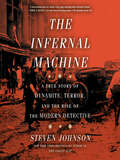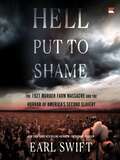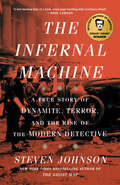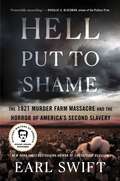Title search results
Showing 1 - 6 of 6 items

The infernal machine: A true story of dynamite, terror, and the rise of the modern detective
By Steven Johnson. 2024
“A fast-burning fuse of a book, every page bursting with revelatory detail."—ERIK LARSON A sweeping account of the anarchists who…
terrorized the streets of New York and the detective duo who transformed policing to meet the threat—a tale of fanaticism, forensic science, and dynamite from the bestselling author of The Ghost Map A CHICAGO PUBLIC LIBRARY BEST BOOK OF THE YEAR • LONGLISTED FOR THE ANDREW CARNEGIE MEDAL FOR EXCELLENCE IN NONFICTION • NOMINATED FOR THE EDGAR AWARD Steven Johnson’s engrossing account of the epic struggle between the anarchist movement and the emerging surveillance state stretches around the world and between two centuries—from Alfred Nobel’s invention of dynamite and the assassination of Czar Alexander II to New York City in the shadow of World War I. April 1914. The NYPD is still largely the corrupt, low-tech organization of the Tammany Hall era. To the extent the police are stopping crime—as opposed to committing it—their role has been almost entirely defined by physical force: the brawn of the cop on the beat keeping criminals at bay with nightsticks and fists. The solving of crimes is largely outside their purview. The new commissioner, Arthur Woods, is determined to change that, but he cannot anticipate the maelstrom of violence that will soon test his science-based approach to policing. Within weeks of his tenure, New York City is engulfed in the most concentrated terrorism campaign in the nation’s history: a five-year period of relentless bombings, many of them perpetrated by the anarchist movement led by legendary radicals Alexander Berkman and Emma Goldman. Coming to Woods’s aide are Inspector Joseph Faurot, a science-first detective who works closely with him in reforming the police force, and Amadeo Polignani, the young Italian undercover detective who infiltrates the notorious Bresci Circle. Johnson reveals a mostly forgotten period of political conviction, scientific discovery, assassination plots, bombings, undercover operations, and innovative sleuthing. The Infernal Machine is the complex pre-history of our current moment, when decentralized anarchist networks have once again taken to the streets to protest law enforcement abuses, right-wing militia groups have attacked government buildings, and surveillance is almost ubiquitous
The bishop and the butterfly: Murder, politics, and the end of the jazz age
By Michael Wolraich. 2024
Vivian Gordon went out before midnight in a velvet dress and mink coat. Her body turned up the next morning…
in a desolate Bronx park, a dirty clothesline wrapped around her neck. At her stylish Manhattan apartment, detectives discovered notebooks full of names—businessmen, socialites, gangsters. And something else—a letter from an anti-corruption commission established by Governor Franklin Delano Roosevelt. Led by the imperious Judge Samuel Seabury, the commission had uncovered a police conspiracy to frame women as prostitutes. Had Vivian Gordon been executed to bury her secrets? As FDR pressed the police to solve her murder, Judge Seabury pursued the trail of corruption to the top of Gotham's powerful political machine—the infamous Tammany Hall
""Hell Put to Shame is a powerfully unsettling portrait of both the single most savage episode in the long decades…
of savagery inflicted by white southerners on their Black neighbors in the 20 th century—and the methodical process that followed to erase those crimes from America's collective memory."" — Douglas A. Blackmon, author of Slavery by Another Name, winner of the Pulitzer Prize From the acclaimed New York Times bestselling author of Chesapeake Requiem comes a gripping new work of narrative nonfiction telling the forgotten story of the mass killing of eleven Black farmhands on a Georgia plantation in the spring of 1921—a crime which exposed for the nation the existence of the "peonage system," a form of legal enslavement established after the Civil War across the American South. On a Sunday morning in the spring of 1921, a small boy made a grim discovery as he played on a riverbank in the cotton country of rural Georgia: the bodies of two drowned men, bound together with wire and chain and weighted with a hundred-pound sack of rocks. Within days a third body turned up in another, nearby river, and in the weeks that followed, eight others. And with them, a deeper horror: all eleven had been kept in virtual slavery before their deaths. In fact, as America was shocked to learn, the dead were among thousands of Black men enslaved throughout the South, in conditions nearly as dire as those before the Civil War. Hell Put to Shame tells the forgotten story of that mass killing, and of the revelations about peonage, or debt slavery, that it placed before a public self-satisfied that involuntary servitude had ended at Appomattox more than fifty years before. By turns police procedural, courtroom drama, and political expose, Hell Put to Shame also reintroduces readers to three Americans who spearheaded the prosecution of John S. Williams, the wealthy plantation owner behind the murders, at a time when White people rarely faced punishment for violence against their Black neighbors. Georgia Governor Hugh M. Dorsey had earned international infamy while prosecuting the 1913 Leo Frank murder case in Atlanta and consequently won the statehouse as a hero of white supremacists—then redeemed himself in spectacular fashion with the "Murder Farm" affair. The remarkable polymath James Weldon Johnson, newly appointed the first Black leader of the National Association for the Advancement of Colored People, marshaled the organization into a full-on war against peonage. And Johnson's lieutenant, Walter F. White, a light-skinned, fair-haired, blue-eyed Black man, conducted undercover work at the scene of lynchings and other Jim Crow atrocities, helping to throw a light on such violence and to hasten its end. The result is a story that remains fresh and relevant a century later, as the nation continues to wrestle with seemingly intractable challenges in matters of race and justice. And the 1921 case at its heart argues that the forces that so roil society today have been with us for generations
The Infernal Machine: A True Story of Dynamite, Terror, and the Rise of the Modern Detective
By Steven Johnson. 2024
&“A fast-burning fuse of a book, every page bursting with revelatory detail.&”—ERIK LARSONA sweeping account of the anarchists who terrorized…
the streets of New York and the detective duo who transformed policing to meet the threat—a tale of fanaticism, forensic science, and dynamite from the bestselling author of The Ghost MapWINNER OF THE EDGAR AWARD • A CHICAGO PUBLIC LIBRARY BEST BOOK OF THE YEAR • LONGLISTED FOR THE ANDREW CARNEGIE MEDAL FOR EXCELLENCE IN NONFICTIONSteven Johnson&’s engrossing account of the epic struggle between the anarchist movement and the emerging surveillance state stretches around the world and between two centuries—from Alfred Nobel&’s invention of dynamite and the assassination of Czar Alexander II to New York City in the shadow of World War I.April 1914. The NYPD is still largely the corrupt, low-tech organization of the Tammany Hall era. To the extent the police are stopping crime—as opposed to committing it—their role has been almost entirely defined by physical force: the brawn of the cop on the beat keeping criminals at bay with nightsticks and fists. The solving of crimes is largely outside their purview.The new commissioner, Arthur Woods, is determined to change that, but he cannot anticipate the maelstrom of violence that will soon test his science-based approach to policing. Within weeks of his tenure, New York City is engulfed in the most concentrated terrorism campaign in the nation&’s history: a five-year period of relentless bombings, many of them perpetrated by the anarchist movement led by legendary radicals Alexander Berkman and Emma Goldman. Coming to Woods&’s aide are Inspector Joseph Faurot, a science-first detective who works closely with him in reforming the police force, and Amadeo Polignani, the young Italian undercover detective who infiltrates the notorious Bresci Circle.Johnson reveals a mostly forgotten period of political conviction, scientific discovery, assassination plots, bombings, undercover operations, and innovative sleuthing. The Infernal Machine is the complex pre-history of our current moment, when decentralized anarchist networks have once again taken to the streets to protest law enforcement abuses, right-wing militia groups have attacked government buildings, and surveillance is almost ubiquitous.
A Mystery Writers of America Edgar Award Finalist (Best Fact Crime)“A haunted, historical legal thriller." — Atlanta Journal-ConstitutionFrom the acclaimed New York…
Times bestselling author of Chesapeake Requiem comes "a powerfully unsettling portrait of the single most savage episode in the long decades of savagery inflicted by white southerners on their Black neighbors in the 20th century" (Douglas A. Blackmon)–the mass killing of eleven Black farmhands on a Georgia plantation in the spring of 1921.On a Sunday morning in the spring of 1921, a small boy made a grim discovery as he played on a riverbank in the cotton country of rural Georgia: the bodies of two drowned men, bound together with wire and chain and weighted with a hundred-pound sack of rocks. Within days a third body turned up in another nearby river, and in the weeks that followed, eight others. And with them a deeper horror: all eleven had been kept in virtual slavery before their deaths. In fact, as America was shocked to learn, the dead were among thousands of Black men enslaved throughout the South in conditions nearly as dire as those before the Civil War.Hell Put to Shame tells the forgotten story of that mass killing and of the revelations about peonage, or debt slavery, that it placed before a public self-satisfied that involuntary servitude had ended at Appomattox more than fifty years before.By turns police procedural, courtroom drama, and political exposé, Hell Put to Shame also reintroduces readers to three Americans who spearheaded the prosecution of John S. Williams, the wealthy plantation owner behind the murders, at a time when white people rarely faced punishment for violence against their Black neighbors. The remarkable polymath James Weldon Johnson, newly appointed the first Black leader of the National Association for the Advancement of Colored People, marshaled the organization into a full-on war against peonage. Johnson’s lieutenant, Walter F. White, a light-skinned, fair-haired, blue-eyed Black man, conducted undercover work at the scene of lynchings and other Jim Crow atrocities, helping to throw a light on such violence and to hasten its end. And Georgia governor Hugh M. Dorsey won the statehouse as a hero of white supremacists—then redeemed himself in spectacular fashion with the “Murder Farm” affair.The result is a story that remains fresh and relevant a century later, as the nation continues to wrestle with seemingly intractable challenges in matters of race and justice. And the 1921 case at its heart argues that the forces that so roil society today have been with us for generations..
A Devil Went Down to Georgia: Race, Power, Privilege, and the Murder of Lita McClinton
By Deb Miller Landau. 2024
A riveting narrative that pieces together the life and murder of Black socialite Lita McClinton Sullivan—and the journey to bring…
her true killer to justice. The 1987 murder of Lita McClinton Sullivan sent shockwaves through the affluent Atlanta suburb of Buckhead, Georgia like few other crimes before it. The neighborhood, with its stately mansions and top-tier schools, was simply not the kind of place where women were gunned down in cold blood in broad daylight. How many socialites had enemies so dangerous they would be murdered by a hitman pretending to deliver roses on an early winter morning? Lita was an intelligent, accomplished, and stunning Black woman from a respected Atlanta family. Her interracial marriage to white millionaire Jim Sullivan, who hailed from working-class Boston, was a newsworthy occurrence in 1970s Georgia. For a while, the couple made the marriage work, but it wasn&’t long before Jim&’s roving eye and controlling nature put Lita on edge. When he bought a mansion in Palm Beach, Florida (without telling her), the façade of their life together began to crumble. Finally, after a decade of marriage, she loaded her belongings in a U-Haul and never looked back. But as the legal battle over the divorce raged and Jim&’s financial outlook grew precarious, he had a chance encounter with a long-haul trucker, a smooth-talking ex-con who said he could he&’d "take care" of Jim&’s wife problem. . . . In A Devil Went Down to Georgia, award-winning writer Deb Miller Landau details the shocking events that followed Lita&’s murder in 1987, including the surprising lack of evidence, racial bias in the justice system, and the international manhunt for Lita&’s killer. Full of twists and turns, legal battles, and the McClinton family&’s unrelenting dedication to justice, Landau's rigorous investigation is the first complete account of this tragic American crime.